Casio fx-5800P User Manual
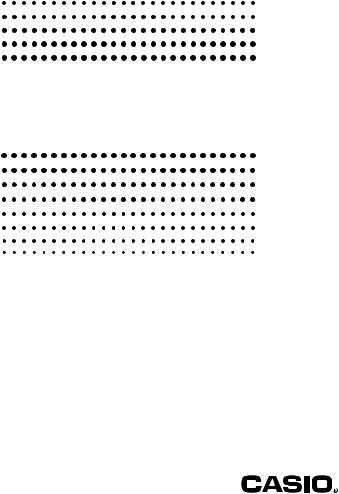
E
fx-5800P
User's Guide
http://world.casio.com/edu/
RJA516644-001V01
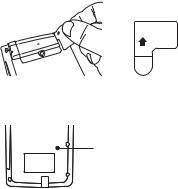
k Remove the insulation sheet!
Your calculator comes with a special insulation sheet, which isolates the battery from the contacts in the battery compartment, to keep the battery from running down during storage and shipment. Be sure to remove the insulation sheet before trying to use the calculator for the first time.
To remove the insulation sheet
1. Pull the tab of the insulation sheet in the direction indicated by the arrow to remove it.
Pull to remove
2.After removing the insulation sheet, press the P button on the back of the calculator with a thin, pointed object to initialize the calculator.
Be sure to perform this step! Do not skip it!
P
P button
k Resetting the Calculator to Initial Defaults
Perform the operation below to return the calculator to its initial default settings. Note that resetting the calculator will also delete all data currently stored in its memory.
To reset the calculator to initial defaults
1.Press Nc3(SYSTEM)3(Reset All).
•This causes the “Reset All?” confirmation message to appear.
2.Press E(Yes).
•If you do not want to reset the calculator to initial defaults, press J(No) instead of E(Yes).
The following is what happens when you reset the calculator to initial defaults.
•The calculation mode and setup configuration return to the initial defaults described under “Clearing the Calculation Mode and Setup Settings (Reset Setup)” (page 13).
•Calculation history data, memory data, statistical calculation sample data, program data, and all other data input by you is deleted.
E-1
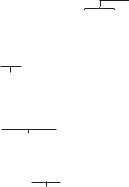
k About this Manual
•Most of the keys perform multiple functions. Pressing 1 or S and then another key will perform the alternate function of the other key. Alternate functions are marked above the keycap.
Alternate function
|
sin–1{D} |
|
Keycap function |
|
s |
|
||
Alternate function operations are notated in this manual as shown below. Example: 1s(sin–1)1E
The notation in parentheses indicates the function executed by the preceding key operation.
•The following shows the notation used in the manual for menu items that appear on the display.
Example: z – {PROG} – {/}
The notation in braces ({ }) indicates the menu item being selected.
•The following shows the notation used in the manual for menu items that appear on the display (which are executed by pressing a number key).
Example: z – {MATH}1(∫dX)
The notation in parentheses indicates the menu item accessed by the preceding number key.
•The displays and illustrations (such as key markings) shown in this User’s Guide are for illustrative purposes only, and may differ somewhat from the actual items they represent.
•The contents of this manual are subject to change without notice.
•In no event shall CASIO Computer Co., Ltd. be liable to anyone for special, collateral, incidental, or consequential damages in connection with or arising out of the purchase or use of this product and items that come with it. Moreover, CASIO Computer Co., Ltd. shall not be liable for any claim of any kind whatsoever by any other party arising out of the use of this product and the items that come with it.
•Company and product names used in this manual may be registered trademarks or trademarks of their respective owners.
k Symbols Used in Examples
Various symbols are used in the examples of this manual to alert you to settings that need to be configured in order to perform the example operation correctly.
• A mark like the ones shown below indicates that you need to change the calculator’s display format setting.
If you see this: |
Change the display |
If you see this: |
Change the display |
|
format setting to: |
format setting to: |
|||
|
|
|||
B |
Natural Display |
b |
Linear Display |
For details, see “Selecting the Display Format (MthIO, LineIO)” (page 11).
E-2
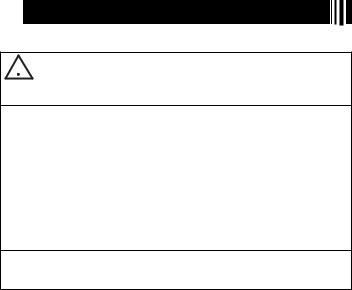
•A mark like the ones shown below indicates that you need to change the calculator’s angle unit setting.
If you see this: |
Change the angle unit |
If you see this: |
Change the angle unit |
|
setting to: |
setting to: |
|||
|
|
|||
|
|
|
|
|
v |
Deg |
V |
Rad |
For details, see “Specifying the Angle Unit” (page 12).



 Safety Precautions
Safety Precautions
Be sure to read the following safety precautions before using this calculator. Be sure to keep all user documentation handy for future reference.
 Caution
Caution
This symbol is used to indicate information that can result in personal injury or material damage if ignored.
Battery
•After removing the battery from the calculator, put it in a safe place where it will not get into the hands of small children and accidentally swallowed.
•Keep batteries out of the reach of small children. If accidentally swallowed, consult with a physician immediately.
•Never charge the battery, try to take the battery apart, or allow the battery to become shorted. Never expose the battery to direct heat or dispose of it by incineration.
•Improperly using a battery can cause it to leak and damage nearby items, and can create the risk of fire and personal injury.
•Always make sure that the battery’s positive k and negative l ends are facing correctly when you load it into the calculator.
•Remove the battery if you do not plan to use the calculator for a long time.
•Use only the type of battery specified for this calculator in this manual.
Disposing of the Calculator
•Never dispose of the calculator by burning it. Doing so can cause certain components to suddenly burst, creating the risk of fire and personal injury.
E-3




 Operating Precautions
Operating Precautions
•Be sure to press the P button on the back of the calculator before using the calculator for the first time. See page 1 for information about the P button.
•Even if the calculator is operating normally, replace the battery at least once a year.
A dead battery can leak, causing damage to and malfunction of the calculator. Never leave a dead battery in the calculator.
•The battery that comes with this unit discharges slightly during shipment and storage. Because of this, it may require replacement sooner than the normal expected battery life.
•Do not use an oxyride battery or any other type of nickel-based primary battery with this product. Incompatibility between such batteries and product specifications can result in shorter battery life and product malfunction.
•Low battery power can cause memory contents to become corrupted or lost completely. Always keep written records of all important data.
•Avoid use and storage of the calculator in areas subjected to temperature extremes.
Very low temperatures can cause slow display response, total failure of the display, and shortening of battery life. Also avoid leaving the calculator in direct sunlight, near a window, near a heater or anywhere else it might be exposed to very high temperatures. Heat can cause discoloration or deformation of the calculator’s case, and damage to internal circuitry.
•Avoid use and storage of the calculator in areas subjected to large amounts of humidity and dust.
Take care never to leave the calculator where it might be splashed by water or exposed to large amounts of humidity or dust. Such conditions can damage internal circuitry.
•Never drop the calculator or otherwise subject it to strong impact.
•Never twist or bend the calculator.
Avoid carrying the calculator in the pocket of your trousers or other tight-fitting clothing where it might be subjected to twisting or bending.
•Never try to take the calculator apart.
•Never press the keys of the calculator with a ballpoint pen or other pointed object.
•Use a soft, dry cloth to clean the exterior of the calculator.
If the calculator becomes very dirty, wipe it off with a cloth moistened in a weak solution of water and a mild neutral household detergent. Wring out all excess liquid before wiping the calculator. Never use thinner, benzene or other volatile agents to clean the calculator. Doing so can remove printed markings and can damage the case.
E-4




 Contents
Contents
Remove the insulation sheet! ............................................................................................. |
1 |
Resetting the Calculator to Initial Defaults.......................................................................... |
1 |
About this Manual............................................................................................................. |
.. 2 |
Symbols Used in Examples................................................................................................ |
2 |
Safety Precautions ................................................................................... |
3 |
Operating Precautions ............................................................................. |
4 |
Before starting a calculation... ............................................................... |
9 |
Turning On the Calculator................................................................................................... |
9 |
Key Markings...................................................................................................................... |
9 |
Reading the Display ........................................................................................................... |
9 |
Calculation Modes and Setup ............................................................... |
10 |
Selecting a Calculation Mode........................................................................................... |
10 |
Calculator Setup............................................................................................................... |
11 |
Clearing the Calculation Mode and Setup Settings (Reset Setup)................................... |
13 |
Using the Function Menu....................................................................... |
14 |
Inputting Calculation Expressions and Values.................................... |
14 |
Inputting a Calculation Expression (Natural Input) ........................................................... |
14 |
Using Natural Display ....................................................................................................... |
16 |
Editing a Calculation......................................................................................................... |
19 |
Finding the Location of an Error ....................................................................................... |
21 |
Displaying Decimal Results while Natural Display is Selected |
|
as the Display Format ............................................................................ |
21 |
Example Calculations....................................................................................................... |
22 |
Using the f Key (S-D Transformation) ............................................... |
22 |
Examples of S-D Transformation ...................................................................................... |
22 |
Basic Calculations.................................................................................. |
23 |
Arithmetic Calculations..................................................................................................... |
23 |
Fractions........................................................................................................................... |
24 |
Percent Calculations......................................................................................................... |
26 |
Degree, Minute, Second (Sexagesimal) Calculations ...................................................... |
27 |
Calculation History and Replay............................................................. |
28 |
Accessing Calculation History .......................................................................................... |
29 |
Using Replay .................................................................................................................... |
29 |
Using Multi-statements in Calculations ............................................... |
30 |
Calculator Memory Operations ............................................................. |
31 |
Using Answer Memory (Ans)............................................................................................ |
32 |
Using Independent Memory ............................................................................................. |
33 |
Using Variables ................................................................................................................ |
34 |
Clearing All Memory Contents ......................................................................................... |
35 |
E-5
Reserving Variable Memory................................................................... |
35 |
User Memory Area ........................................................................................................... |
35 |
Using Extra Variables ....................................................................................................... |
36 |
Using π and Scientific Constants.......................................................... |
37 |
Pi (π)................................................................................................................................. |
37 |
Scientific Constants.......................................................................................................... |
38 |
Scientific Function Calculations ........................................................... |
40 |
Trigonometric and Inverse Trigonometric Functions ......................................................... |
40 |
Angle Unit Conversion...................................................................................................... |
41 |
Hyperbolic and Inverse Hyperbolic Functions .................................................................. |
41 |
Exponential and Logarithmic Functions ........................................................................... |
41 |
Power Functions and Power Root Functions.................................................................... |
42 |
Integration Calculation...................................................................................................... |
43 |
Derivative.......................................................................................................................... |
45 |
Second Derivative ............................................................................................................ |
46 |
Σ Calculation .................................................................................................................... |
46 |
Coordinate Conversion (Rectangular ↔ Polar) ................................................................ |
47 |
Random Number Functions ............................................................................................. |
49 |
Other Functions................................................................................................................ |
50 |
Using Engineering Notation .................................................................. |
53 |
Using 103 Engineering Notation (ENG)............................................................................ |
53 |
ENG Conversion Examples.............................................................................................. |
54 |
Using Engineering Symbols ............................................................................................. |
54 |
Complex Number Calculations (COMP) ............................................... |
55 |
Inputting Complex Numbers ............................................................................................. |
55 |
Complex Number Display Setting..................................................................................... |
56 |
Complex Number Calculation Result Display Examples .................................................. |
56 |
Conjugate Complex Number (Conjg) ............................................................................... |
57 |
Absolute Value and Argument (Abs, Arg) ......................................................................... |
57 |
Extracting the Real Part (ReP) and Imaginary Part (ImP) of a Complex Number ............ |
58 |
Overriding the Default Complex Number Display Format................................................. |
58 |
Matrix Calculations (COMP) .................................................................. |
59 |
Matrix Calculation Overview............................................................................................. |
59 |
About the Mat Ans Screen ............................................................................................... |
59 |
Inputting and Editing Matrix Data ..................................................................................... |
59 |
Performing Matrix Calculations......................................................................................... |
62 |
Sequence Calculations (RECUR) .......................................................... |
65 |
Sequence Calculation Overview ...................................................................................... |
65 |
Creating a Sequence Table .............................................................................................. |
68 |
Sequence Calculation Precautions .................................................................................. |
69 |
Equation Calculations (EQN)................................................................. |
69 |
Equation Calculation Overview ........................................................................................ |
69 |
Selecting an Equation Type .............................................................................................. |
71 |
Inputting Values for Coefficients ....................................................................................... |
71 |
E-6
Viewing Equation Solutions .............................................................................................. |
72 |
Statistical Calculations (SD/REG) ......................................................... |
72 |
Statistical Sample Data .................................................................................................... |
72 |
Performing Single-variable Statistical Calculations .......................................................... |
75 |
Performing Paired-variable Statistical Calculations .......................................................... |
77 |
Statistical Calculation Examples ...................................................................................... |
84 |
Base-n Calculations (BASE-N) .............................................................. |
86 |
Performing Base-n Calculations ....................................................................................... |
86 |
Converting a Displayed Result to another Number Base ................................................. |
87 |
Specifying a Number Base for a Particular Value............................................................. |
88 |
Performing Calculations Using Logical Operations and Negative Binary Values ............. |
89 |
CALC........................................................................................................ |
90 |
Using CALC...................................................................................................................... |
90 |
SOLVE...................................................................................................... |
92 |
Expressions Supported by SOLVE................................................................................... |
92 |
Using SOLVE.................................................................................................................... |
92 |
Creating a Number Table from a Function (TABLE) ............................ |
94 |
TABLE Mode Overview..................................................................................................... |
94 |
Creating a Number Table.................................................................................................. |
96 |
Number Table Creation Precautions................................................................................. |
97 |
Built-in Formulas .................................................................................... |
97 |
Using Built-in Formulas .................................................................................................... |
97 |
Built-in Formula Names .................................................................................................... |
99 |
User Formulas ................................................................................................................ |
102 |
Program Mode (PROG)......................................................................... |
104 |
Program Mode Overview................................................................................................ |
105 |
Creating a Program ........................................................................................................ |
105 |
Running a Program ........................................................................................................ |
109 |
File Screen Operations................................................................................................... |
111 |
Deleting a Program......................................................................................................... |
112 |
Command Reference............................................................................ |
113 |
Program Commands ...................................................................................................... |
113 |
Statistical Calculation Commands.................................................................................. |
121 |
Other PROG Mode Commands...................................................................................... |
122 |
Data Communication (LINK)................................................................ |
124 |
Connecting Two fx-5800P Calculators to Each Other .................................................... |
124 |
Transferring Data Between fx-5800P Calculators........................................................... |
124 |
Memory Manager (MEMORY)............................................................... |
126 |
Deletable Data Types and Supported Delete Operations............................................... |
127 |
Using Memory Manager ................................................................................................. |
127 |
E-7
Appendix ............................................................................................... |
128 |
Calculation Priority Sequence ........................................................................................ |
128 |
Stack Limitations ............................................................................................................ |
130 |
Calculation Ranges, Number of Digits, and Precision.................................................... |
130 |
Error Messages .............................................................................................................. |
132 |
Before assuming malfunction of the calculator... ........................................................... |
135 |
Lower Battery Indicator ................................................................................................. |
135 |
Power Requirements ............................................................................ |
136 |
Specifications ....................................................................................... |
137 |
E-8




 Before starting a calculation...
Before starting a calculation...
k Turning On the Calculator
Press o. This displays the same screen that was on the display when you last turned off the calculator.
A Adjusting Display Contrast
If the figures on the display become hard to read, try adjusting display contrast.
1.Press Nc3(SYSTEM)1(Contrast).
• This displays the contrast adjustment screen.
2.Use d and e to adjust display contrast.
3.After the setting is the way you want, press J.
Note
You can also use d and e to adjust contrast while the calculation mode menu that appears when you press the N key is on the display.
A Turning Off the Calculator
Press 1o(OFF).
k Key Markings
%BIN [ 

|
Function |
Key Marking Color |
To perform the function: |
|
|
|
|
1 |
ln |
|
Press the key. |
2 |
% |
Orange |
Press 1 and then press the key. |
3 |
[ |
Red |
Press S and then press the key. |
4 |
BIN |
Green |
In the BASE-N Mode, press the key. |
|
|
|
|
k Reading the Display
A Input Expressions and Calculation Results
This calculator can display both the expressions you input and calculation results on the same screen.
E-9
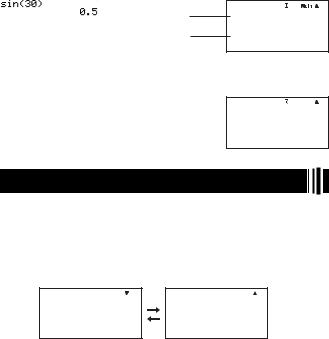
Input expression
Calculation result
A Display Symbols
The symbols described below appear on the display of the calculator to indicate the current calculation mode, the calculator setup, the progress of calculations, and more.
The nearby sample screen shows the 7 symbol.
The 7 symbol turns on when degrees (Deg) are selected for the default angle unit (page 12).



 Calculation Modes and Setup
Calculation Modes and Setup
k Selecting a Calculation Mode
Your calculator has 11 “calculation modes”.
A Selecting a Calculation Mode
1.Press N.
•This displays the calculation mode menu. Use c and f to switch between menu screen 1 and screen 2.
Screen 1 |
Screen 2 |
2. Perform one of the following operations to select the calculation mode you want.
To select this calculation mode: |
Go to this screen: |
And press this key: |
|
COMP (Computation) |
|
1(COMP) |
|
BASE-N (Base n) |
|
2(BASE-N) |
|
|
|
|
|
SD (Single Variable Statistics) |
|
3(SD) |
|
|
|
|
|
REG (Paired Variable Statistics) |
Screen 1 |
4(REG) |
|
|
|
||
PROG (Programming) |
5(PROG) |
||
|
|||
|
|
|
|
RECUR (Recursion) |
|
6(RECUR) |
|
|
|
|
|
TABLE (Tables) |
|
7(TABLE) |
|
|
|
|
|
EQN (Equations) |
|
8(EQN) |
|
|
|
|
E-10

To select this calculation mode: |
Go to this screen: |
And press this key: |
LINK (Communication) |
|
1(LINK) |
MEMORY (Memory Management) |
Screen 2 |
2(MEMORY) |
SYSTEM (Contrast Adjustment, Reset) |
|
3(SYSTEM) |
|
|
|
• To exit the calculation mode menu without changing the calculation mode, press N.
k Calculator Setup
The calculator setup can be used to configure input and output settings, calculation parameters, and other settings. The setup can be configured using setup screens, which you access by pressing 1 N(SETUP). There are two setup screens, and you can use f and c to navigate between them.
A Selecting the Display Format (MthIO, LineIO)
You can select either natural display (MthIO) or linear display (LineIO) for expressions you input and for calculation results.
Natural Display (MthIO)
Natural display displays fraction, square root, derivative, integral, exponential, logarithmic, and other mathematical expressions just as they are written. This format is applied both for input expressions and for calculation results. When natural display is selected, the result of a calculation is displayed using fraction, square root, or π notation whenever possible.
For example, the calculation 1 ÷ 2 produces the result |
1 |
, while π ÷ 3 results in |
1 |
π. |
|
3 |
|||
2 |
|
|
||
Linear Display (LineIO)
With linear display, expressions and functions are input and displayed using a special format
defined by your calculator. For example, |
1 |
would be input as 1 { 2, and log24 would be |
|
2 |
|||
input as log(2,4). |
|
||
|
|
When linear display is selected all calculation results, except for fractions, are displayed using decimal values.
To select this display fomat: |
Perform this key operation: |
|
|
Natural Display (MthIO) |
1N1(MthIO) |
|
|
Linear Display (LineIO) |
1N2(LineIO) |
|
|
Note
For information about the input procedures when using the natural display and linear display, see “Inputting Calculation Expressions and Values” on page 14 of this manual and the sections of this manual that explanation of each type of calculation.
E-11
A Specifying the Angle Unit
To select this angle unit: |
Perform this key operation: |
||
Degrees |
1N3(Deg) |
||
Radians |
1N4(Rad) |
||
Grads |
1N5(Gra) |
||
|
(90˚ = |
π |
radians = 100 grads) |
A Specifying the Display Digits |
2 |
|
|
|
|
|
|
To specify this display digit setting: |
Perform this key operation: |
|
|
|
|
Number of Decimal Places |
1N6(Fix)0(0) to 9(9) |
|
|
|
|
Significant Digits |
1N7(Sci)1(1) to 9(9), 0(10) |
|
|
|
|
Exponential Display Range |
1N8(Norm)1(Norm1) or |
|
2(Norm2) |
||
|
The following explains how calculation results are displayed in accordance with the setting you specify.
•From zero to nine decimal places are displayed in accordance with the number of decimal places (Fix) you specify. Calculation results are rounded off to the specified number of digits.
Example: 100 ÷ 7 = 14.286 (Fix = 3)
14.29(Fix = 2)
•After you specify the number of significant digits with Sci, calculation results are displayed using the specified number of significant digits and 10 to the applicable power. Calculation results are rounded off to the specified number of digits.
Example: 1 ÷ 7 = 1.4286 × 10–1 |
(Sci = 5) |
1.429 × 10–1 |
(Sci = 4) |
•Selecting Norm1 or Norm2 causes the display to switch to exponential notation whenever the result is within the ranges defined below.
Norm1: 10–2 > x , x > 1010
Norm2: 10–9 > x , x > 1010 |
|
|
Example: 100 ÷ 7 |
= 14.28571429 |
(Norm1 or Norm2) |
1 ÷ 200 |
= 5. × 10–3 |
(Norm1) |
|
0.005 |
(Norm2) |
A Specifying the Fraction Display Format
To specify this fraction format for |
Perform this key operation: |
|
display of calculation results: |
||
|
||
|
|
|
Mixed Fractions |
1Nc1(ab/c) |
|
|
|
|
Improper Fractions |
1Nc2(d/c) |
|
|
|
E-12
A Specifying the Engineering Symbol Setting
This setting lets you turn engineering symbols on and off. For more information, see “Using Engineering Symbols” on page 54.
To do this: |
Perform this key operation: |
|
|
Turn engineering symbols on |
1Nc3(ENG)1(EngOn) |
|
|
Turn engineering symbols off |
1Nc3(ENG)2(EngOff) |
|
|
While engineering symbols are turned on (EngOn), engineering symbols are used when a calculation result is outside of the range of 1 < x < 1000.
A Specifying the Complex Number Display Format
You can specify either rectangular coordinate format or polar coordinate format for complex number calculation results.
To specify this complex number format |
Perform this key operation: |
|
for display of calculation results: |
||
|
||
|
|
|
Rectangular Coordinates |
1Nc4(COMPLX)1(a+bi) |
|
|
|
|
Polar Coordinates |
1Nc4(COMPLX)2(r Ƨ) |
ENG conversion (page 53) is not possible while polar coordinate format is selected.
A Specifying the Statistical Frequency Setting
Use the key operations below to turn statistical frequency on or off during SD Mode and REG Mode calculations (page 72).
To select this frequency setting: |
Perform this key operation: |
|
|
Frequency On |
1Nc5(STAT)1(FreqOn) |
|
|
Frequency Off |
1Nc5(STAT)2(FreqOff) |
|
|
A Changing the BASE-N Mode Negative Value Setting
You can use the key operations below to enable or disable use of negative values in the BASE-N Mode.
To specify this setting: |
Perform this key operation: |
|
|
Negative values enabled |
1Nc6(BASE-N)1(Signed) |
|
|
Negative values disabled |
1Nc6(BASE-N)2(Unsigned) |
k Clearing the Calculation Mode and Setup Settings
(Reset Setup)
Perform the following key operation to reset the calculation mode and setup settings.
Nc3(SYSTEM)2(Reset Setup)E(Yes)
If you do not want to reset the calculator’s settings, press J(No) in place of E(Yes) in the above operation.
E-13

Calculation Mode..................................... |
COMP |
Setup Settings |
|
Display Format .................................... |
MthIO |
Angle Unit............................................ |
Deg |
Exponential Display............................. |
Norm1 |
Fraction Format .................................. |
d/c |
Complex Number Format .................... |
a+bi |
Engineering Symbol ............................ |
EngOff |
Statistical Frequency ........................... |
FreqOff |
BASE-N Negatives .............................. |
Signed |



 Using the Function Menu
Using the Function Menu
The function menu provides you with access to various mathematical functions, commands, constants, symbols, and other special operations.
A Displaying the Function Menu
Press z. The function menu shown below will appear if you press z while in the COMP Mode for example.
A Exiting the Function Menu
Press J.
Inputting Calculation Expressions
and Values
k Inputting a Calculation Expression (Natural Input)
The natural input system of your calculator lets you input a calculation expression just as it is written and execute it by pressing E. The calculator determines the proper priority sequence for addition, subtraction, multiplication, division, fractions and parentheses automatically.
Example: 2 (5 + 4) – 2 × (–3) =
b
2(5+4)-
2*-3E
E-14
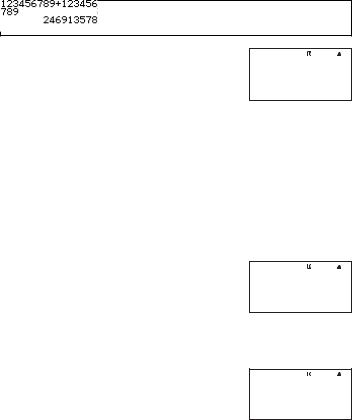
A Inputting Scientific Functions with Parentheses (sin, cos, ', etc.)
Your calculator supports input of the scientific functions with parentheses shown below. Note that after you input the argument, you need to press ) to close the parentheses.
sin(, cos(, tan(, sin–1(, cos–1(, tan–1(, sinh(, cosh(, tanh(, sinh–1(, cosh–1(, tanh–1(, log(, ln(, e^(, 10^(, '(, 3'(, Abs(, Pol(, Rec(, ∫(, d/dx(, d 2/dx2(, Σ(, P(, Q(, R(, Arg(, Conjg(, ReP(, ImP(, Not(, Neg(, Det(, Trn(, Rnd(, Int(, Frac(, Intg(, RanInt#(
Example: sin 30 =
b
s30)E
Note
Some functions require a different input sequence when using natural input. For more information, see “Inputting Calculation Expressions Using Natural Display” on page 17.
A Omitting the Multiplication Sign
You can omit the multiplication sign in the following cases.
•Immediately before an open parenthesis: 2 × (5 + 4)
•Immediately before a scientific function with parentheses: 2 × sin(30), 2 × '(3)
•Before a prefix symbol (excluding the minus sign): 2 × h123
•Before a variable name, constant, or random number: 20 × A, 2 × π, 2 × i
A Final Closed Parenthesis
You can omit one or more closed parentheses that come at the end of a calculation, immediately before the w key is pressed.
Example: (2 + 3) (4 − 1) = 15
b
(2+3) (4-1E
A Calculation Expression Wrapping (Linear Display)
When using linear display, calculation expressions that are longer than 16 characters (numbers, letters, and operators) are wrapped automatically to the next line.
Example: 123456789 + 123456789 = 246913578
b
123456789+
123456789E
E-15

A Number of Input Characters (Bytes)
As you input a mathematical expression, it is stored in memory called an “input area,” which has a capacity of 127 bytes. This means you can input up to 127 bytes for a single mathematical expression.
When linear display is selected as the display format, each function normally uses one or two bytes of memory. With the natural display format, each function use four or more bytes of memory. For more information, see “Inputting Calculation Expressions Using Natural Display” on page 17.
Normally, the cursor that indicates the current input location on the display is either a flashing vertical bar (|) or horizontal bar ( ). When the remaining capacity of the input area is 10 bytes or less, the cursor changes to a flashing box (k).
If this happens, stop input of the current expression at some suitable location and calculate its result.
k Using Natural Display
While natural display is selected as the display format (page 11), you can input fractions and some scientific functions just as they are written.
A Natural Display Basics
The table below lists the types of scientific functions that you can input using natural display format.
•The *1 column shows the number of bytes of memory used up by each scientific function. See “Number of Input Characters (Bytes)” (page 16) for more information.
•For information about the *2 column, see “Using Values and Expressions as Arguments” (page 18).
Scientific Functions that Support Natural Display
Function |
Key Operation |
*1 |
*2 |
|
|
|
|
Improper Fraction |
' |
9 |
Yes |
|
|
|
|
Mixed Fraction |
1'(() |
14 |
No |
|
|
|
|
log(a,b) |
z – {MATH}c7(logab) |
7 |
Yes |
|
|
|
|
10^x |
1l($) |
4 |
Yes |
e^x |
1i(%) |
4 |
Yes |
Square Root (') |
! |
4 |
Yes |
Cube Root (3') |
1((#) |
9 |
Yes |
|
|
|
|
Square |
x |
4 |
No |
|
|
|
|
Reciprocal |
1)(x–1) |
5 |
No |
Power |
6 |
4 |
Yes |
Power Root |
16(") |
9 |
Yes |
Absolute Value (Abs) |
z – {MATH}c1(Abs) |
4 |
Yes |
Integral |
z – {MATH}1(∫dX) |
8 |
Yes |
E-16

Function |
Key Operation |
*1 |
*2 |
Derivative |
z – {MATH}2(d/dX) |
7 |
Yes |
Second Derivative |
z – {MATH}3(d2/dX2) |
7 |
Yes |
Σ Calculation |
z – {MATH}4(Σ() |
11 |
Yes |
Note
If you include values or expressions in parentheses (( and )) while using natural display, the height of the parentheses will adjust automatically depending on whether they enclose one line or two lines. Regardless of their height, opening and closing parentheses take up one byte of memory each.
Inputting Calculation Expressions Using Natural Display
1.To input a specific function, perform the operation in the “Key Operation” column of the “Scientific Functions that Support Natural Display” table.
2.At the input fields indicated by , input the required values and expressions.
• Use the cursor keys to move between the input fields of the expression.
Example: To input 1 + 2 2 × 3
B
Specify fraction input: |
' |
Input the numerator: |
1+2 |
Move the cursor to the denominator: c
Input the denominator: 2*3
Execute the calculation: E
Important!
•Certain types of expressions can cause the height of a calculation formula to be greater than one display line. The maximum allowable height of a calculation formula is two display screens (31 dots × 2). Further input will become impossible if the height of the calculation you are inputting exceeds the allowable limit.
•Nesting of functions and parentheses is allowed. Further input will become impossible if you nest too many functions and/or parentheses. If this happens, divide the calculation into multiple parts and calculate each part separately.
E-17
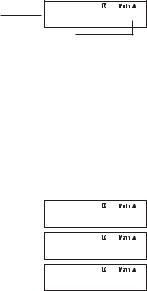
A Scrolling the Screen Left and Right
The screen will show up to 14 characters when inputting with natural display. When you input more than 14 characters, the screen will scroll automatically. If this happens, the ] symbol will turn on to let you know that the expression runs off the left side of the display.
B |
Input expression |
|
1111 + 2222 + 3333 + 444 |
|
Displayed expression
Cursor
•While the ] symbol is turned on, you can use the d key to move the cursor to the left and scroll the screen.
•Scrolling to the left causes part of the expression to run off the right side of the display, which is indicated by the ' symbol on the right. While the ' symbol is on the screen, you can use the e key to move the cursor to the right and scroll the screen.
A Using Values and Expressions as Arguments
When inputting with natural display, in certain cases you can use a value or an expression that is enclosed in parentheses that you have already input as the argument of a scientific function (such as '), the numerator of a fraction, etc. For the sake of explanation here, a natural display function that supports the use of previously input values or parenthetical expressions is called an “insertable natural display function”.
Example: To insert the natural display function ' into the parenthetical expression in the following calculation: 1 + (2 + 3) + 4
B |
(Move the cursor immediately to the left of |
|
the parenthetical expression.) |
|
1Y(INS) |
! 
Note
•Not all natural display functions are insertable. Only the scientific functions for which “Yes” appears in the column of the table under “Scientific Functions that Support Natural Display” (page 16) are insertable.
•The cursor can be immediately to the left of a parenthetical expression, a numeric value, or a fraction. Inserting an insertable function will make the parenthetical expression, value, or fraction the argument of the inserted function.
•If the cursor is located immediately to the left of a scientific function, the entire function becomes the argument of the inserted function.
E-18
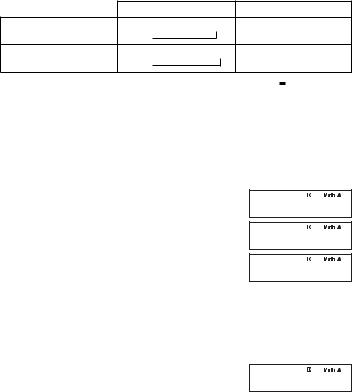
k Editing a Calculation
A Insert Mode and Overwrite Mode
The calculator has two input modes. The insert mode inserts your input at the cursor location, shifting anything to the right of the cursor to make room. The overwrite mode replaces the key operation at the cursor location with your input.
Only the insert mode is available when natural display is selected as the display format. You cannot change to the overwrite mode. When linear display is selected as the display format, you can choose either the insert mode or overwrite mode for input.
Original Expression |
Pressing + |
Insert Mode
Cursor
Overwrite Mode
Cursor
A vertical cursor (|) indicates the insert mode, while a horizontal cursor ( ) indicates the overwrite mode.
Selecting an Input Mode
The initial default input mode setting is insert mode. If you have linear display selected as the display format and want to change to the overwrite mode, press: 1Y(INS).
A Editing a Key Operation You Just Input
When the cursor is located at the end of the input, press Y to delete the last key operation you performed.
Example: To correct 369 × 13 so it becomes 369 × 12
Bb |
369*13 |
Y 
2 
A Deleting a Key Operation
With the insert mode, use d and e to move the cursor to the right of the key operation you want to delete and then press Y. With the overwrite mode, move the cursor to the key operation you want to delete and then press Y. Each press of Y deletes one key operation.
Example: To correct 369 × × 12 so it becomes 369 × 12
Insert Mode |
|
Bb |
369**12 |
E-19

dd 
Y 
Overwrite Mode
b369**12 
ddd 
Y 
A Editing a Key Operation within an Expression
With the insert mode, use d and e to move the cursor to the right of the key operation you want to edit, press Y to delete it, and then perform the correct key operation. With the overwrite mode, move the cursor to the key operation you want to correct and then perform the correct key operation.
Example: To correct cos(60) so it becomes sin(60)
Insert Mode |
|
Bb |
c60) |
|
dddY |
|
s |
Overwrite Mode
bc60)  dddd
dddd 
s 
A Inserting Key Operations into an Expression
Be sure to select the insert mode whenever you want to insert key operations into an expression. Use d and e to move the cursor to the location where you want to insert the key operations and then perform them.
E-20
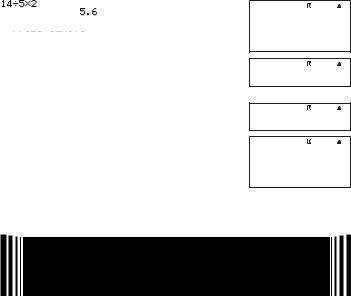
k Finding the Location of an Error
If your calculation expression is incorrect, an error message will appear on the display when you press E to execute it. Pressing the J, d, or e key after an error message appears will cause the cursor to jump to the location in your calculation that caused the error so you can correct it.
Example: When you input 14 ÷ 0 × 2 = instead of 14 ÷ 5 × 2 = (The following examples use the insert mode.)
b
14/0*2E
J (or e, d)

 Location of Error
Location of Error
D5
E
•Instead of pressing J, e or d while an error message is displayed to find the location of the error, you could also press o to clear the calculation.
Displaying Decimal Results while Natural Display is Selected as the Display Format
Pressing E to execute a calculation while natural display is selected will display the result in natural format. Pressing 1E will execute the calculation and display the result in decimal format.
To display the result in this format: |
Perform this key operation: |
|
|
Natural Format |
E |
|
|
Decimal Format |
1E |
|
|
Note
When linear display is selected as the display format, execution of a calculation is always displayed in linear (decimal) format, regardless of whether you press E or 1E.
E-21
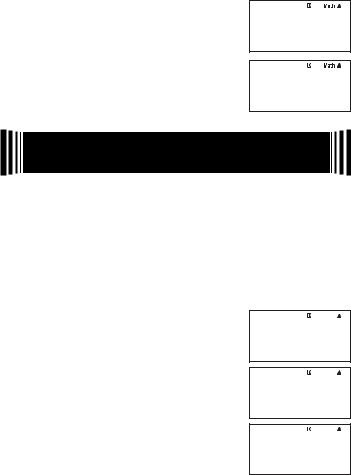
k Example Calculations
Example: '2 +'8 = 3'2
B
!2e+!8E
Produce the result in decimal format:
!2e+!81E
Using the f Key
(S-D Transformation)
You can use the fkey to transform a value between its decimal (D) form and its standard (S) form (fraction, ', π).
Important!
•Depending on the type of calculation result that is on the display when you press the f key, the conversion process may take some time to perform.
•With certain calculation results, pressing the f key will not convert the displayed value.
k Examples of S-D Transformation
Example 1: While linear display is selected as the display format, to perform the calculation 111 ÷ 33, and then convert the result to fraction format
b
111/33E
f
f
E-22
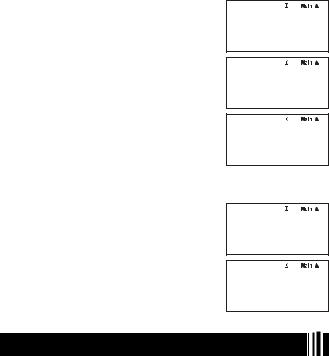
Note
•Each press of the f key toggles the displayed result between the two forms.
•The format of the fraction depends on which fraction display format (improper or mixed) is currently selected (page 12).
Example 2: While natural display is selected as the display format, to perform the calculation 111 ÷ 33, and then convert the result to decimal format
B
111/33E
f
f
Example 3: While natural display is selected as the display format, to perform the π calculation shown below, and then convert the result to decimal format
B
15(π)*'2c5E
f



 Basic Calculations
Basic Calculations
Unless otherwise noted, the calculations in this section can be performed in any of the calculator’s calculation mode, except for the BASE-N Mode.
k Arithmetic Calculations
Arithmetic calculations can be used to perform addition (+), subtraction (-), multiplication (*), and division (/).
E-23

Example 1: 2.5 + 1 − 2 = 1.5
b
2.5+1-2E
Example 2: 7 × 8 − 4 × 5 = 36
b
7*8-4*5E
•The calculator determines the proper priority sequence for addition, subtraction, multiplication, and division automatically. See “Calculation Priority Sequence” on page 128 for more information.
k Fractions
Keep in mind when inputting fractions on your calculator that the input procedure you need to use depends on whether natural display or linear display is selected as the display format (page 11), as shown below.
Natural Display:
Key Operation |
Display |
|||||
|
|
|
|
|
|
|
Improper Fraction |
'7c3 |
|
7 |
|
|
|
3 |
|
|
||||
|
|
|
|
|||
|
|
|
|
|
|
|
Mixed Fraction |
1'(() |
2 |
1 |
|
||
2e1c3 |
|
|
||||
|
3 |
|
||||
Linear Display:
Key Operation |
Display |
|
Improper Fraction |
7'3 |
7 { 3 |
|
||
|
|
Numerator Denominator |
Mixed Fraction |
2'1'3 |
2 { 1 { 3 |
|
||
Integer Numerator Denominator
As you can see above, natural display lets you input fractions as they appear in your textbook, while linear display requires input of a special symbol ({).
Note
•Under initial default settings, fractions are displayed as improper fractions.
•Fraction calculation results are always reduced automatically before being displayed. Executing 2 { 4 =, for example, will display the result 1 { 2.
E-24
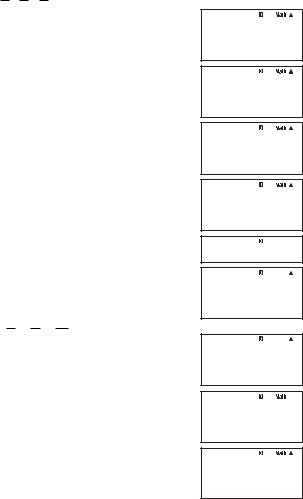
A Fraction Calculation Examples
Example 1:
B
b
Example 2:
b
B
2 + 1 = 7
3 2 6
3 1 + 1 2 = 4 11
4 3 1 2
'2c3
e+
'1c2
E
2'3+1'2 
E
(Fraction Display Format: ab/c)
3'1'4+
1'2'3E
1'(()3e1c4e+
1'(()1e2c3E
E-25
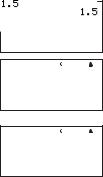
Note
•If the total number of elements (integer digits + numerator digits + denominator digits + separator symbols) that make up a mixed fraction expression is greater than 10, the calculation result will be displayed in decimal form.
•If an input calculation includes a mixture of fraction and decimal values, the result will be displayed in decimal format.
•You can input integers only for the elements of a fraction.
A Switching between Improper Fraction and Mixed Fraction
Format
To convert an improper fraction to a mixed fraction (or a mixed fraction to an improper
b |
d |
fraction), press 1f( a — — ). |
|
c |
c |
A Switching between Fraction and Decimal Format
Use the procedure below to toggle a displayed calculation result between fraction and decimal format.
Example: 1.5 = |
3 |
, |
3 |
= 1.5 |
|
2 |
|||
2 |
|
|
||
b
1.5E
f
The current fraction display format setting determines if an improper or mixed fraction is displayed.
f
Note
The calculator cannot switch from decimal to fraction format if the total number of elements (integer digits + numerator digits + denominator digits + separator symbols) that make up a mixed fraction is greater than 10.
k Percent Calculations
Inputting a value and with a percent (%) sign makes the value a percent. The percent (%) sign uses the value immediately before it as the argument, which is simply divided by 100 to get the percentage value.
A Percent Calculation Examples
All of the following examples are performed using linear display (b).
E-26

Example 1: 2% = 0.02 ( |
2 |
) |
|
|
|
||||
100 |
|
|
|
|
|
|
|
|
21,(%)E |
Example 2: 150 × 20% = 30 |
(150 × |
20 |
) |
|
|
|
100 |
|
|
|
150*201,(%)E |
|||
Example 3: What percent of 880 is 660? |
||||
|
|
660/880 |
||
|
|
|
|
1,(%)E |
Example 4: Increase 2500 by 15%.
2500+2500*
151,(%)E
Example 5: Reduce 3500 by 25%.
3500-3500*
251,(%)E
k Degree, Minute, Second (Sexagesimal) Calculations
You can perform calculations using sexagesimal values, and you can convert between sexagesimal and decimal.
A Inputting Sexagesimal Values
The following is basic syntax for inputting a sexagesimal value. {Degrees}${Minutes}${Seconds}$
Example: To input 2°30´30˝
b
2e30e30eE
•Note that you must always input something for the degrees and minutes, even if they are zero.
Example: To input 0°00´30˝, press 0$0$30$.
E-27
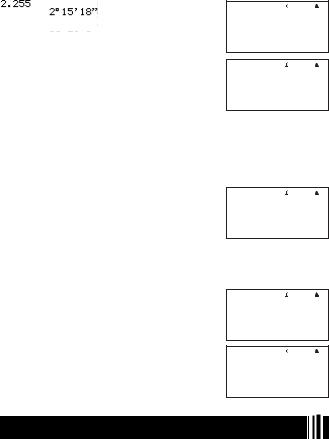
A Sexagesimal Calculation Examples
•The following types of sexagesimal calculations will produce sexagesimal results.
-Addition or subtraction of two sexagesimal values
-Multiplication or division of a sexagesimal value and a decimal value
Example 1: 2°20´30˝ + 39´30˝ = 3°00´00˝
b2e20e30e+
0e39e30eE
Example 2: 2°20´00˝ × 3.5 = 8°10´00˝
b2e20e*
3.5E
A Performing a Decimal Calculation to Obtain a Sexagesimal
Result
You can use the “'DMS” command to execute a decimal calculation and obtain a sexagesimal result. The “'DMS” command can be used in the COMP Mode only.
Example: Perform the calculation 100 ÷ 3 so it produces a sexagesimal result
b
100/3E z – {ANGLE}4('DMS)E
A Converting between Sexagesimal and Decimal
Pressing $ while a calculation result is displayed will toggle the value between sexagesimal and decimal.
Example: To convert 2.255 to sexagesimal
b
2.255E
e



 Calculation History and Replay
Calculation History and Replay
You can use calculation history in the COMP and BASE-N Modes.
E-28

k Accessing Calculation History
The ` symbol in the upper right corner of the display indicates that there is data stored in calculation history. To view the data in calculation history, press f. Each press of f will scroll upwards (back) one calculation, displaying both the calculation expression and its result.
Example:
B1+1E2+2E
3+3E
f
f
While scrolling through calculation history records, the $ symbol will appear on the display, which indicates that there are records below (newer than) the current one. When this symbol is turned on, press c to scroll downwards (forward) through calculation history records.
Important!
•Calculation history records are all cleared when you change to a different calculation mode, or when you change the display format.
•Calculation history capacity is limited. Whenever you perform a new calculation while calculation history is full, the oldest record in calculation history is deleted automatically to make room for the new one.
Note
A calculation that contains any of the following functions is not stored in calculation history when it is executed.
CALC, SOLVE, Built-in Formulas, User Formulas
k Using Replay
While a calculation history record is on the display, press d or e to display the cursor and enter the editing mode. Pressing e displays the cursor at the beginning of the calculation expression, while d displays it at the end. After you make the changes you want, press E to execute the calculation.
Example: 4 × 3 + 2.5 = 14.5 4 × 3 – 7.1 = 4.9
b4*3+2.5E
E-29
